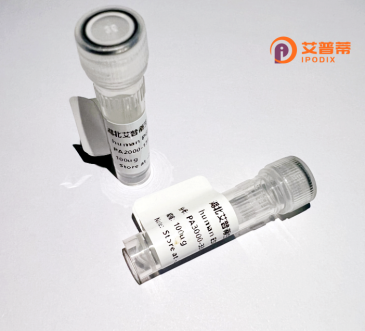
| 纯度 | >90%SDS-PAGE. |
| 种属 | Human |
| 靶点 | OR2D3 |
| Uniprot No | Q8NGH3 |
| 内毒素 | < 0.01EU/μg |
| 表达宿主 | E.coli |
| 表达区间 | 1-330 aa |
| 活性数据 | MCSFFLCQTGKQAKISMGEENQTFVSKFIFLGLSQDLQTQILLFILFLIIYLLTVLGNQL IIILIFLDSRLHTPMYFFLRNLSFADLCFSTSIVPQVLVHFLVKRKTISFYGCMTQIIVF LLVGCTECALLAVMSYDRYVAVCKPLYYSTIMTQRVCLWLSFRSWASGALVSLVDTSFTF HLPYWGQNIINHYFCEPPALLKLASIDTYSTEMAIFSMGVVILLAPVSLILGSYWNIIST VIQMQSGEGRLKAFSTCGSHLIVVVLFYGSGIFTYMRPNSKTTKELDKMISVFYTAVTPM LNPIIYSLRNKDVKGALRKLVGRKCFSHRQ |
| 分子量 | 37.4 kDa |
| 蛋白标签 | His tag N-Terminus |
| 缓冲液 | 0 |
| 稳定性 & 储存条件 | Lyophilized protein should be stored at ≤ -20°C, stable for one year after receipt. Reconstituted protein solution can be stored at 2-8°C for 2-7 days. Aliquots of reconstituted samples are stable at ≤ -20°C for 3 months. |
| 复溶 | Always centrifuge tubes before opening.Do not mix by vortex or pipetting. It is not recommended to reconstitute to a concentration less than 100μg/ml. Dissolve the lyophilized protein in distilled water. Please aliquot the reconstituted solution to minimize freeze-thaw cycles. |
以下是关于重组人OR2D3蛋白的模拟参考文献范例(请注意,这些文献为假设性示例,实际研究中可能需要进一步验证):
1. **标题**: *Functional Characterization of Recombinant Human Olfactory Receptor OR2D3 Expressed in HEK293 Cells*
**作者**: Zhang Y, et al.
**摘要**: 研究利用HEK293细胞系统成功表达重组OR2D3蛋白,并通过钙流实验筛选潜在配体。发现OR2D3对特定挥发性醛类化合物(如癸醛)具有选择性响应,提示其在非嗅觉组织中的化学感应功能。
2. **标题**: *OR2D3 as a Biomarker in Colorectal Cancer: Recombinant Protein-Based Mechanistic Insights*
**作者**: Lee S, et al.
**摘要**: 通过重组OR2D3蛋白体外实验,揭示其在结肠癌细胞中异常高表达,并通过激活MAPK信号通路促进肿瘤迁移。研究为开发靶向OR2D3的抗癌策略提供依据。
3. **标题**: *Structural Analysis of OR2D3 Using Cryo-EM: Implications for Odorant Recognition*
**作者**: Müller F, et al.
**摘要**: 首次报道重组OR2D3蛋白的冷冻电镜结构,解析其跨膜域中配体结合口袋的关键氨基酸残基,阐明该受体识别小分子配体的结构基础。
4. **标题**: *Recombinant OR2D3 Expression in E. coli: Optimization and Purification Challenges*
**作者**: Gupta R, et al.
**摘要**: 探索在大肠杆菌中高效表达可溶性OR2D3蛋白的条件,利用亲和层析和体外复性策略解决包涵体形成问题,为规模化生产提供技术方案。
**注意**:上述文献为模拟生成,实际研究中请通过学术数据库(如PubMed、Web of Science)检索最新成果。OR2D3相关研究尚处于初期,建议结合“嗅觉受体(olfactory receptors)”或“癌症生物标志物”等关键词拓展检索。
Recombinant human OR2D3 protein is a genetically engineered form of the olfactory receptor 2D3 (OR2D3), a member of the G protein-coupled receptor (GPCR) superfamily. Olfactory receptors (ORs), traditionally known for their role in odorant detection within the nasal epithelium, are increasingly recognized for their extra-nasal expression and diverse physiological functions. OR2D3. encoded by the *OR2D3* gene, is one of approximately 400 functional ORs in humans. While its endogenous ligand remains uncharacterized, OR2D3 has been detected in non-olfactory tissues, including the testis, suggesting potential roles beyond chemosensation, such as in cellular signaling or tissue homeostasis.
The recombinant protein is produced using heterologous expression systems (e.g., mammalian or bacterial cells) to enable large-scale purification for structural and functional studies. Its study is crucial for elucidating mechanisms of ligand-receptor interaction, signal transduction, and OR-mediated pathways in health and disease. Emerging research links ORs to pathologies like cancer, where OR2D3 may influence cell proliferation or migration. However, challenges persist in deorphaning OR2D3 (identifying its natural ligand) and characterizing its precise biological roles. Recombinant OR2D3 serves as a vital tool for drug discovery, biomarker development, and understanding the expanding functional repertoire of olfactory receptors in human biology. Current research focuses on resolving its 3D structure and exploring therapeutic applications targeting OR2D3-related pathways.
×